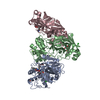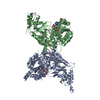[English] 日本語
 Yorodumi
Yorodumi- PDB-6uin: Role of Beta-hairpin motifs in the DNA duplex opening by the Rad4... -
+ Open data
Open data
- Basic information
Basic information
| Entry | Database: PDB / ID: 6uin | ||||||
|---|---|---|---|---|---|---|---|
| Title | Role of Beta-hairpin motifs in the DNA duplex opening by the Rad4/XPC nucleotide excision repair complex | ||||||
 Components Components |
| ||||||
 Keywords Keywords | DNA BINDING PROTEIN/DNA / DNA damage recognition / DNA damage repair / nucleotide excision repair / Beta-hairpin motif / xeroderma pigmentosum / XPC / Rad4 / molecular dynamics simulations / DNA BINDING PROTEIN-DNA complex | ||||||
| Function / homology |  Function and homology information Function and homology informationPNGase complex / nucleotide-excision repair factor 2 complex / single-strand break-containing DNA binding / XPC complex / nucleotide-excision repair, DNA damage recognition / K48-linked polyubiquitin modification-dependent protein binding / proteasome binding / DNA topological change / polyubiquitin modification-dependent protein binding / mismatch repair ...PNGase complex / nucleotide-excision repair factor 2 complex / single-strand break-containing DNA binding / XPC complex / nucleotide-excision repair, DNA damage recognition / K48-linked polyubiquitin modification-dependent protein binding / proteasome binding / DNA topological change / polyubiquitin modification-dependent protein binding / mismatch repair / ERAD pathway / ubiquitin binding / nucleotide-excision repair / single-stranded DNA binding / protein-macromolecule adaptor activity / proteasome-mediated ubiquitin-dependent protein catabolic process / damaged DNA binding / negative regulation of transcription by RNA polymerase II / mitochondrion / nucleoplasm / nucleus / cytosol / cytoplasm Similarity search - Function | ||||||
| Biological species |  | ||||||
| Method |  X-RAY DIFFRACTION / X-RAY DIFFRACTION /  SYNCHROTRON / SYNCHROTRON /  MOLECULAR REPLACEMENT / Resolution: 3.348 Å MOLECULAR REPLACEMENT / Resolution: 3.348 Å | ||||||
 Authors Authors | Paul, D. / Min, J.-H. | ||||||
| Funding support |  United States, 1items United States, 1items
| ||||||
 Citation Citation |  Journal: Nucleic Acids Res. / Year: 2021 Journal: Nucleic Acids Res. / Year: 2021Title: Tethering-facilitated DNA 'opening' and complementary roles of beta-hairpin motifs in the Rad4/XPC DNA damage sensor protein Authors: Paul, D. / Mu, H. / Tavakoli, A. / Dai, Q. / Chen, X. / Chakraborty, S. / He, C. / Ansari, A. / Broyde, S. / Min, J.H. #1:  Journal: Nat Commun / Year: 2015 Journal: Nat Commun / Year: 2015Title: Kinetic gating mechanism of DNA damage recognition by Rad4/XPC. Authors: Chen, X. / Velmurugu, Y. / Zheng, G. / Park, B. / Shim, Y. / Kim, Y. / Liu, L. / Van Houten, B. / He, C. / Ansari, A. / Min, J.H. | ||||||
| History |
|
- Structure visualization
Structure visualization
| Structure viewer | Molecule:  Molmil Molmil Jmol/JSmol Jmol/JSmol |
|---|
- Downloads & links
Downloads & links
- Download
Download
| PDBx/mmCIF format |  6uin.cif.gz 6uin.cif.gz | 259.7 KB | Display |  PDBx/mmCIF format PDBx/mmCIF format |
|---|---|---|---|---|
| PDB format |  pdb6uin.ent.gz pdb6uin.ent.gz | 202.7 KB | Display |  PDB format PDB format |
| PDBx/mmJSON format |  6uin.json.gz 6uin.json.gz | Tree view |  PDBx/mmJSON format PDBx/mmJSON format | |
| Others |  Other downloads Other downloads |
-Validation report
| Summary document |  6uin_validation.pdf.gz 6uin_validation.pdf.gz | 463.2 KB | Display |  wwPDB validaton report wwPDB validaton report |
|---|---|---|---|---|
| Full document |  6uin_full_validation.pdf.gz 6uin_full_validation.pdf.gz | 478.6 KB | Display | |
| Data in XML |  6uin_validation.xml.gz 6uin_validation.xml.gz | 23.3 KB | Display | |
| Data in CIF |  6uin_validation.cif.gz 6uin_validation.cif.gz | 31.4 KB | Display | |
| Arichive directory |  https://data.pdbj.org/pub/pdb/validation_reports/ui/6uin https://data.pdbj.org/pub/pdb/validation_reports/ui/6uin ftp://data.pdbj.org/pub/pdb/validation_reports/ui/6uin ftp://data.pdbj.org/pub/pdb/validation_reports/ui/6uin | HTTPS FTP |
-Related structure data
| Related structure data |  4yirS S: Starting model for refinement |
|---|---|
| Similar structure data |
- Links
Links
- Assembly
Assembly
| Deposited unit | 
| ||||||||
|---|---|---|---|---|---|---|---|---|---|
| 1 |
| ||||||||
| Unit cell |
|
- Components
Components
| #1: Protein | Mass: 62559.445 Da / Num. of mol.: 1 / Fragment: UNP residues 101-632 Source method: isolated from a genetically manipulated source Source: (gene. exp.)  Gene: RAD4, YER162C / Production host:  Trichoplusia ni (cabbage looper) / References: UniProt: P14736 Trichoplusia ni (cabbage looper) / References: UniProt: P14736 |
|---|---|
| #2: Protein | Mass: 17783.352 Da / Num. of mol.: 1 / Fragment: UNP residues 230-398 Source method: isolated from a genetically manipulated source Source: (gene. exp.)  Gene: RAD23, YEL037C, SYGP-ORF29 / Production host:  Trichoplusia ni (cabbage looper) / References: UniProt: P32628 Trichoplusia ni (cabbage looper) / References: UniProt: P32628 |
| #3: DNA chain | Mass: 7254.775 Da / Num. of mol.: 1 / Source method: obtained synthetically / Source: (synth.)  |
| #4: DNA chain | Mass: 7013.417 Da / Num. of mol.: 1 / Source method: obtained synthetically / Source: (synth.)  |
| Has ligand of interest | N |
| Has protein modification | Y |
-Experimental details
-Experiment
| Experiment | Method:  X-RAY DIFFRACTION / Number of used crystals: 1 X-RAY DIFFRACTION / Number of used crystals: 1 |
|---|
- Sample preparation
Sample preparation
| Crystal | Density Matthews: 2.45 Å3/Da / Density % sol: 49.78 % |
|---|---|
| Crystal grow | Temperature: 277 K / Method: vapor diffusion, hanging drop / pH: 6.8 Details: 50 mM BTP-HCl, 200 mM sodium chloride, 12% isopropanol, 100 mM calcium chloride |
-Data collection
| Diffraction | Mean temperature: 277 K / Serial crystal experiment: N |
|---|---|
| Diffraction source | Source:  SYNCHROTRON / Site: SYNCHROTRON / Site:  APS APS  / Beamline: 21-ID-D / Wavelength: 0.979 Å / Beamline: 21-ID-D / Wavelength: 0.979 Å |
| Detector | Type: MARMOSAIC 300 mm CCD / Detector: CCD / Date: Jan 1, 2016 |
| Radiation | Monochromator: Si(111) / Protocol: SINGLE WAVELENGTH / Monochromatic (M) / Laue (L): M / Scattering type: x-ray |
| Radiation wavelength | Wavelength: 0.979 Å / Relative weight: 1 |
| Reflection | Resolution: 3.34→50 Å / Num. obs: 12932 / % possible obs: 99 % / Redundancy: 6.4 % / Rsym value: 0.036 / Net I/σ(I): 19.1 |
| Reflection shell | Highest resolution: 3.34 Å |
- Processing
Processing
| Software |
| ||||||||||||||||||||||||||||||||||||||||||||||||||||||||||||
|---|---|---|---|---|---|---|---|---|---|---|---|---|---|---|---|---|---|---|---|---|---|---|---|---|---|---|---|---|---|---|---|---|---|---|---|---|---|---|---|---|---|---|---|---|---|---|---|---|---|---|---|---|---|---|---|---|---|---|---|---|---|
| Refinement | Method to determine structure:  MOLECULAR REPLACEMENT MOLECULAR REPLACEMENTStarting model: PDB entry 4YIR Resolution: 3.348→38.833 Å / SU ML: 0.48 / Cross valid method: THROUGHOUT / σ(F): 1.37 / Phase error: 30.22
| ||||||||||||||||||||||||||||||||||||||||||||||||||||||||||||
| Solvent computation | Shrinkage radii: 0.9 Å / VDW probe radii: 1.11 Å | ||||||||||||||||||||||||||||||||||||||||||||||||||||||||||||
| Displacement parameters | Biso max: 332.92 Å2 / Biso mean: 148.4842 Å2 / Biso min: 76.8 Å2 | ||||||||||||||||||||||||||||||||||||||||||||||||||||||||||||
| Refinement step | Cycle: final / Resolution: 3.348→38.833 Å
| ||||||||||||||||||||||||||||||||||||||||||||||||||||||||||||
| Refine LS restraints |
| ||||||||||||||||||||||||||||||||||||||||||||||||||||||||||||
| LS refinement shell | Refine-ID: X-RAY DIFFRACTION / Rfactor Rfree error: 0
|
 Movie
Movie Controller
Controller










 PDBj
PDBj









































